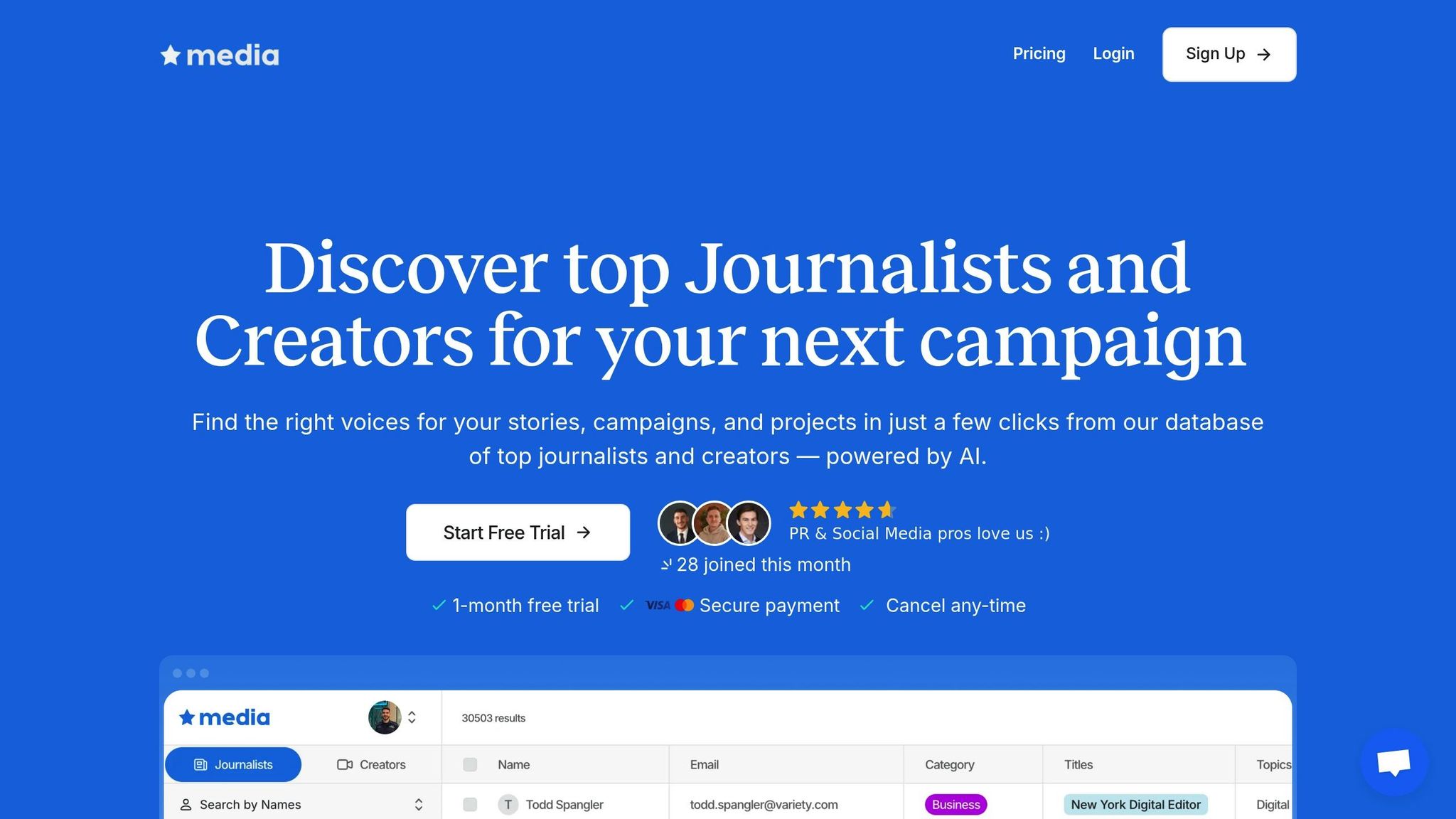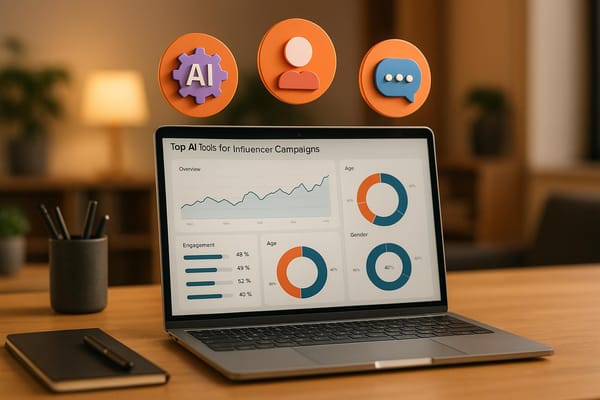How AI Simplifies Media Contact Research
AI tools revolutionize media contact research, saving time and enhancing outreach accuracy for PR professionals.

Finding the right journalists for your PR campaigns doesn’t have to be a time-consuming hassle. AI tools like Media AI streamline media contact research by providing access to an updated database of over 30,000 journalists and creators. These platforms use advanced filtering to match your campaign with the most relevant contacts, saving hours of manual work and ensuring accuracy.
Here’s why AI is transforming media outreach:
- Save Time: AI tools eliminate the need for manual research, completing tasks in minutes that used to take hours.
- Real-Time Accuracy: Databases are continuously updated to reflect journalists’ latest roles, beats, and contact details.
- Targeted Outreach: Advanced filters let you pinpoint contacts based on location, industry, or engagement metrics.
- Improved Efficiency: Export and manage tailored contact lists seamlessly for better campaign organization.
Switching to AI-powered solutions like Media AI allows PR professionals to focus on crafting personalized pitches and building meaningful connections, rather than wasting time on outdated spreadsheets. Plans start at $99/month, making it an affordable way to elevate your media outreach efforts. Learn more at trymedia.ai.
PR Pros, Meet Your New Assistant: Creating a Media List with AI Agents
Main Benefits of AI-Powered Media Contact Research
AI-powered media contact research has revolutionized the way PR professionals approach their work. By addressing common challenges in traditional media outreach, it opens up smarter, more efficient ways to plan and execute campaigns.
Automation and Time Savings
One of the standout benefits of AI tools is how much time they save. Traditional media contact research often requires hours of manual work - cross-checking publications, verifying email addresses, and building spreadsheets. AI tools simplify this process by instantly identifying the right journalists and creators based on your campaign's needs.
For example, Media AI offers a database of over 30,000 contacts and scans publications and social media in real time. This means PR teams get up-to-date profiles without spending days digging through outdated lists. Beyond contact discovery, AI tools analyze journalist activity - like writing frequency, engagement levels, and recent topics - so you can target those actively covering your industry. Instead of wasting time on inactive contacts, you can focus on journalists who are currently engaged with relevant topics.
The result? Research that used to take an entire day can now be done in under an hour. This time savings allows PR professionals to shift their focus to crafting impactful pitches and building relationships, rather than getting bogged down in tedious research. And since these tools ensure real-time accuracy, your outreach becomes far more effective.
Better Accuracy and Real-Time Data
In traditional PR, outdated contact information is a constant headache. Journalists frequently change jobs, beats, or contact preferences, leaving static databases unreliable. This often leads to bounced emails, wasted time, and missed opportunities.
AI-powered platforms eliminate this issue by continuously updating their databases. These tools monitor journalist movements, verify contact details, and track changes in real time. This ensures PR teams always have access to current, accurate data, reducing the chance of misdirected outreach.
But the accuracy doesn’t stop there. AI tools also track journalists' recent articles, social media activity, and engagement patterns, giving PR teams a deeper understanding of their interests and coverage areas. For example, Media AI keeps its contact information updated and verifies email addresses while monitoring publication schedules. This means your pitches are more likely to land in the right inbox, at the right time.
Having access to this real-time data not only streamlines outreach but also ensures that every effort is backed by reliable, up-to-date information.
Advanced Filtering and Targeting
AI tools shine when it comes to precision targeting. Traditional research methods often rely on broad criteria like a journalist’s publication or general beat. AI platforms, on the other hand, allow PR teams to filter contacts using highly specific parameters.
These platforms enable searches based on multiple criteria at once, such as location, audience size, publication type, recent topics, or engagement metrics. This level of detail ensures your outreach is laser-focused on journalists who are genuinely interested in your campaign’s subject matter.
For instance, Media AI offers advanced search and filtering options, making it easy to build tailored contact lists. Whether you're launching a tech product in Silicon Valley or promoting a healthcare initiative nationwide, you can create a list that fits your exact needs.
AI tools also analyze journalists’ past work and social media activity to uncover their preferences and communication styles. This allows PR teams to craft personalized pitches that align with individual interests, increasing the chances of coverage and fostering stronger relationships.
How to Use Media AI for Media Contact Research

Media AI streamlines the process of finding and managing media contacts, combining precision with ease of use. Here's how you can integrate it into your outreach efforts.
Getting Started with Media AI
To begin, head over to trymedia.ai, click on "Try Free Now", and follow the onboarding steps. You can sign up using your email or Google account.
Once you're in, the dashboard gives you access to an AI-powered database featuring over 30,000 journalists and creators. You’ll have three subscription options to choose from: Journalist Database ($99/month), Creators Database ($99/month), or the Full Database ($149/month). There’s no contract, so you can adjust your plan based on your campaign needs. This flexibility ensures you’re only paying for what you need, when you need it.
Using Filters to Find the Right Contacts
Media AI’s filtering tools make it easy to pinpoint the perfect contacts for your campaign. You can filter by location, publication type, or beat coverage to refine your search. For instance, if you’re promoting a tech product launch on the West Coast, you could filter for journalists in California, Oregon, and Washington who specialize in technology or startups.
The platform also allows you to combine multiple criteria, giving you highly targeted results. On top of that, the AI can suggest additional contacts based on your initial search, helping you expand your reach while staying relevant to your niche.
These features ensure your outreach is both focused and efficient, cutting down on the time spent manually searching for the right contacts.
Exporting and Managing Contact Lists
Once you’ve created a refined contact list, Media AI makes managing and exporting your data straightforward.
You can export your list in either CSV or Excel format, making it easy to integrate with your CRM or email tools. Simply select the contacts you want, and all the data - like verified email addresses, social media profiles, and publication details - will transfer seamlessly.
For teams managing multiple campaigns, Media AI also lets you save and organize contact lists by category, such as product launches, regions, or campaign types. This keeps your outreach efforts well-organized and efficient, no matter how many campaigns you’re juggling.
Manual Research vs. AI-Driven Solutions: A Comparison
Manual research often feels like a tedious puzzle, piecing together outdated contact information. It demands hours of effort to verify just a handful of details, and even then, the accuracy can fade quickly as journalists change roles or update their contact information.
AI-powered platforms like Media AI take a completely different approach. By tapping into a vast, constantly updated database and leveraging advanced filtering tools, they deliver real-time, precise insights. This means users can quickly identify a wide range of relevant contacts without worrying about outdated information. The table below illustrates how manual research stacks up against Media AI's efficient, data-driven approach.
Comparison Table: Manual Research vs. Media AI
| Factor | Manual Research | Media AI |
|---|---|---|
| Time Efficiency | Hours of tedious manual effort | Results delivered in just minutes |
| Database Size | Limited to personal/local networks | Access to over 30,000 journalists and creators |
| Data Accuracy | Quickly becomes outdated | Continuously updated information |
| Filtering Options | Limited manual sorting | AI-powered filters by location, beat, and publication |
| Export Options | Manual spreadsheet creation | Automated CSV/Excel export |
| Scalability | Limited by individual capacity | Handles extensive searches with ease |
Why AI is the Future of Media Contact Research
For PR professionals, AI tools like Media AI are a game-changer. What once required an entire team can now be accomplished by a single person. Starting at just $99 per month, the platform provides cost-effective access to powerful tools, with full database access available for $149 per month.
One of the standout benefits of AI platforms is their ability to ensure data accuracy. These tools continuously cross-reference multiple sources, keeping contact details fresh and reliable. This level of precision boosts the effectiveness of campaigns - an essential advantage in the fast-paced U.S. media environment.
AI also excels in targeted outreach. Instead of relying on generic, one-size-fits-all lists, PR professionals can pinpoint journalists based on specific criteria like industry focus, geographic location, or story angle. This tailored approach significantly improves engagement rates.
For agencies juggling multiple clients across various sectors, the adaptability of AI platforms is invaluable. They allow teams to seamlessly switch between campaigns without needing to start research from scratch. Features like saved contact lists and organizational tools streamline workflows, making it easier to manage diverse projects efficiently. These capabilities not only save time but also set the foundation for more effective U.S.-focused campaigns.
Best Practices for Using AI in U.S.-Focused Campaigns
Running a successful PR campaign in the U.S. means balancing AI-driven precision with personal, thoughtful outreach. Platforms like Media AI can be game-changers, but how you use them matters. To thrive, you’ll need to understand the U.S. media landscape, legal requirements, and cultural nuances. When done right, these practices will not only help you meet legal standards but also build meaningful connections with journalists and creators.
Navigating U.S. Privacy Laws
Privacy laws in the U.S. can feel like a patchwork, with regulations varying by state. Key examples include California's CCPA and Virginia's CDPA. If you're using AI tools for contact research, staying compliant with these laws is crucial.
Media AI provides access to updated, publicly available contact information, but compliance doesn’t stop there. Make sure your outreach emails include clear opt-out options, and always honor unsubscribe requests promptly.
For added protection, consider a double opt-in process for your media lists. After generating a list with AI, send a brief, personalized email asking journalists if they’d like to receive future pitches. It’s an extra step, but it reduces legal risks and often boosts response rates.
Document your data sources and retention practices. Be ready to explain how you obtained a journalist's contact information - whether it came from publicly available sources through your AI platform - and ensure you’re not holding onto data longer than necessary for your campaign.
Blending AI Insights with Personal Touches
A database like Media AI’s 30,000+ journalists and creators offers an incredible starting point, but it’s the personal touches that make your outreach stand out. Use filters to narrow down contacts by beat, location, or publication type, then dig deeper with individual research.
Take time to review each journalist’s recent work - look at their last five to ten articles. What topics are they covering? What angles do they prefer? This step ensures your pitch aligns with their interests and style.
Timing is everything in media outreach. For most U.S. journalists, the best window is 9:00 AM to 11:00 AM EST, though this varies by time zone and beat. For example, West Coast tech reporters might prefer afternoon pitches, while East Coast financial journalists often check emails early in the morning.
Craft personalized subject lines that reference a journalist’s recent work or a relevant trend. Instead of generic lines like “Story Opportunity,” try something specific, such as “Your Tesla article: New EV charging insights.” This shows you’ve done your homework and increases the chances your email gets opened.
Mastering the U.S. Media Landscape
The U.S. media scene has its own rhythms and preferences that AI alone can’t fully grasp. For example, national news cycles slow down during major holidays like Thanksgiving or the stretch between Christmas and New Year’s. Timing your campaigns around these patterns can make a big difference.
Geography also matters. A story that’s a hit in Silicon Valley might not resonate in the Midwest. Use Media AI’s location filters to tailor your outreach by region, and adjust your messaging to reflect local interests.
Different types of publications have unique needs. Daily newspapers often work on tight deadlines, needing stories they can publish within 24-48 hours. Monthly magazines, on the other hand, plan 2-3 months in advance. Trade publications focus on niche, industry-specific topics, while general interest outlets cater to broader audiences. Media AI can help you identify these distinctions so you can fine-tune your approach.
Building relationships with journalists takes time - think 6-12 months of consistent, meaningful engagement. Use AI-generated contact lists as a starting point for long-term connections, not just one-off pitches.
Lastly, respect how journalists prefer to communicate. Some prefer email, others respond better to Twitter DMs, and a few might even welcome phone calls. Pay attention to their responses and adapt your approach accordingly. Use Media AI’s export tools to log preferred communication methods in your CRM, and segment your outreach to align with regional and publication-specific preferences.
Conclusion: How AI Changes Media Contact Research
AI has reshaped how PR professionals and marketers approach media contact research. Tools like Media AI have replaced outdated manual processes with accurate, up-to-date data, offering faster results and more effective targeting to amplify campaign success.
With a database of over 30,000 journalists and creators, Media AI delivers real-time insights, advanced filtering options, and seamless export capabilities. These features ensure your outreach is directed at the right people - those genuinely interested in your message. For campaigns focused on the U.S., AI tools also help you navigate regional nuances and identify the best times to connect with media contacts. Together, these advancements simplify your workflow and improve your results.
Whether you're a PR pro juggling multiple clients, a startup founder aiming for high-profile coverage, or a social media agency diving into influencer collaborations, AI-powered research can make a big difference. Media AI offers plans starting at $99/month with no long-term commitments, giving you access to a powerful database and tools to elevate your next PR or influencer campaign. Learn more at trymedia.ai.
FAQs
How does Media AI keep its journalist database accurate and up-to-date?
Media AI leverages AI-driven verification along with weekly updates to keep its journalist database precise and dependable. This consistent effort ensures a contact accuracy rate exceeding 95%, giving users peace of mind about the reliability of the information they rely on.
Through automated data checks and frequent updates, Media AI not only saves you valuable time but also guarantees access to the most up-to-date and relevant media contacts.
What makes Media AI faster and more effective than traditional methods for finding media contacts?
Media AI brings together a database of over 30,000 journalists and creators with AI-driven tools designed to make research faster and easier. It allows you to quickly find, filter, and export contact details, cutting out the hassle of manual searching.
By taking care of repetitive tasks and delivering precise, up-to-date information, Media AI enables PR teams, social media agencies, startups, and freelancers to focus on building real connections instead of getting stuck in endless research. It’s a smart solution for simplifying PR and influencer marketing workflows.
How can PR professionals use Media AI to enhance their outreach and achieve better campaign results?
PR professionals can rely on Media AI to simplify outreach efforts and enhance campaign performance. With access to a massive database of over 30,000 journalists and creators, the platform provides tools to pinpoint the right contacts for your campaign. This not only saves time but also ensures your outreach is highly targeted.
The platform’s AI-powered insights take personalization to the next level. By analyzing journalist preferences and identifying optimal times to connect, users can craft pitches that genuinely resonate. Plus, Media AI’s exporting features make it easy to create customized media lists, freeing up PR teams to focus on developing impactful campaigns. This streamlined, data-driven approach means less manual work and better results for your outreach efforts.





